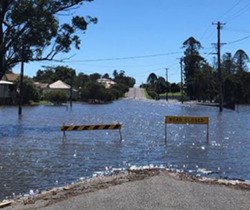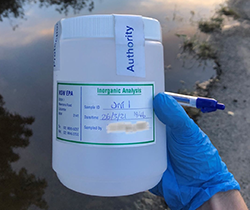Severe weather? Be prepared.
La Nina continued its weather pattern into the autumn months and the Bureau of Meteorology’s warning for severe weather activity was realised through the March floods in many parts of NSW.

Flooded river in the state's north
As a key responder to impacts from severe weather, the EPA wants licensees, councils and the community to plan and be prepared to do their best to protect our environment and the health and safety of all.
The EPA plays an important role under the State Emergency Management framework, supporting the community and combat agencies in responding to emergencies and disasters.
All licensees should have Pollution Incident Response Management Plans (PIRMPs) in place, so they know what to do when something goes wrong. Through the bushfires and the floods of the past 12 months, we saw the value these preparations can bring when they are done right. Every business with a PIRMP needs to make sure their staff know the plan and their role when an incident happens so they can minimise the impact on the environment and their own operations.

EPA's Incident Management room in action at Parramatta
Our Incident Management team joined other key emergency agencies including the Rural Fire Service and Safework at the State Emergency Operations Centre at Homebush in March to assist with assessing and managing the clean-up of flood-impacted communities. We also have an ongoing role in clean up works. For the next few months, we will have a dedicated team working with contractors and the community to clean up flood-strewn debris from our creeks, rivers and shorelines.
Snapshot - Flood Clean-up
- The EPA’s Environment Line received three times the normal incoming traffic on Monday 22 March, following the most prevalent flood weekend, answering 133 phone calls on that day and responding to 70 flood-related emails.
- The initial clean-up focused on flood generated waste and pollution posing a risk to human health, safety and the environment (eg hazardous chemicals, maritime hazards).
- Things like agricultural waste, huge hay bales, chemical drums, furnishings, plastic chairs, mattresses and parts of caravans, have all been pulled from waterways. Approximately 10% have been hazardous materials.
- So far, an estimated 787 tonnes of flood debris have been removed from the Hawkesbury and Corindi shorelines.

Sampling water quality in flood-affected waterways
Being prepared for blackwater incidents
Heavy rain can have a significant effect on water quality and aquatic wildlife and often leads to pungent odours on our waterways.
“When the recent floodwaters broke riverbanks and flowed over low-lying areas surrounding the rivers, they picked up large quantities of organic matter, including decaying vegetation and leaves, as well as dirt, sand and other debris,” EPA Director Regulatory Operations Adam Gilligan said.
“Although it’s an important process for healthy river function, the decomposition of organic matter drains oxygen levels in the water and releases tannins which give the water a distinctive black colour,” Adam said.
“This natural process is commonly known as ‘blackwater’ and is likely to cause multiple fish deaths in these rivers. The stagnant water also contributes to some really nasty odours, which can smell like rotten egg gas.
“Blackwater after flooding is a natural feature of Australian river systems and so the capacity to prevent and manage the impacts of blackwater is limited, but we want the community to understand how this natural phenomenon happens, particularly when we see scores of dead fish, as a result.”
EPA officers were out sampling the Hunter River in March from Raymond Terrace to Sandgate and identified low oxygen levels which had resulted in fish kills.
Tips for preventing flood pollution
- Maintain sewage treatment plants at levels to allow inflows
- Empty home septic tanks or seal outflows if you know a flood is coming
- Keep chemicals and pesticides in sealed containers above potential flood lines – if they do end up as debris, dispose of them safely at your nearest Community Recycling Centre cleanout event.
- Remove flood debris as soon as it’s safe to do so
- Be aware that ‘blackwater’ events often follow flooding and avoid affected rivers and other waterways, stay out of the water as much as possible and stay safe
- If you are concerned, contact the EPA’s Environment Line on 131 555 or info@epa.nsw.gov.au
- Licensees, have your PIRMP in place and tested annually
Support for flood clean-up
The NSW Government waste levy has been waived for all flood-impacted areas to assist with the clean-up.
Flood and storm-impacted people and businesses can access all available State Government and Federal Government support, through the NSW Government’s Disaster Customer Care program by calling Service NSW on 13 77 88 or visiting www.service.nsw.gov.au

